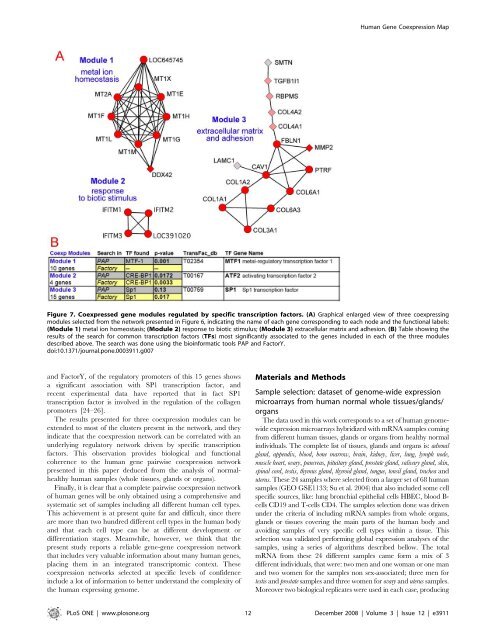Alberto Risueño Pérez - Gredos - Universidad de Salamanca
Alberto Risueño Pérez - Gredos - Universidad de Salamanca
Alberto Risueño Pérez - Gredos - Universidad de Salamanca
Create successful ePaper yourself
Turn your PDF publications into a flip-book with our unique Google optimized e-Paper software.
and FactorY, of the regulatory promoters of this 15 genes shows<br />
a significant association with SP1 transcription factor, and<br />
recent experimental data have reported that in fact SP1<br />
transcription factor is involved in the regulation of the collagen<br />
promoters [24–26].<br />
The results presented for three coexpression modules can be<br />
exten<strong>de</strong>d to most of the clusters present in the network, and they<br />
indicate that the coexpression network can be correlated with an<br />
un<strong>de</strong>rlying regulatory network driven by specific transcription<br />
factors. This observation provi<strong>de</strong>s biological and functional<br />
coherence to the human gene pairwise coexpression network<br />
presented in this paper <strong>de</strong>duced from the analysis of normalhealthy<br />
human samples (whole tissues, glands or organs).<br />
Finally, it is clear that a complete pairwise coexpression network<br />
of human genes will be only obtained using a comprehensive and<br />
systematic set of samples including all different human cell types.<br />
This achievement is at present quite far and difficult, since there<br />
are more than two hundred different cell types in the human body<br />
and that each cell type can be at different <strong>de</strong>velopment or<br />
differentiation stages. Meanwhile, however, we think that the<br />
present study reports a reliable gene-gene coexpression network<br />
that inclu<strong>de</strong>s very valuable information about many human genes,<br />
placing them in an integrated transcriptomic context. These<br />
coexpression networks selected at specific levels of confi<strong>de</strong>nce<br />
inclu<strong>de</strong> a lot of information to better un<strong>de</strong>rstand the complexity of<br />
the human expressing genome.<br />
Materials and Methods<br />
Human Gene Coexpression Map<br />
Figure 7. Coexpressed gene modules regulated by specific transcription factors. (A) Graphical enlarged view of three coexpressing<br />
modules selected from the network presented in Figure 6, indicating the name of each gene corresponding to each no<strong>de</strong> and the functional labels:<br />
(Module 1) metal ion homeostasis; (Module 2) response to biotic stimulus; (Module 3) extracellular matrix and adhesion. (B) Table showing the<br />
results of the search for common transcription factors (TFs) most significantly associated to the genes inclu<strong>de</strong>d in each of the three modules<br />
<strong>de</strong>scribed above. The search was done using the bioinformatic tools PAP and FactorY.<br />
doi:10.1371/journal.pone.0003911.g007<br />
Sample selection: dataset of genome-wi<strong>de</strong> expression<br />
microarrays from human normal whole tissues/glands/<br />
organs<br />
The data used in this work corresponds to a set of human genomewi<strong>de</strong><br />
expression microarrays hybridized with mRNA samples coming<br />
from different human tissues, glands or organs from healthy normal<br />
individuals. The complete list of tissues, glands and organs is: adrenal<br />
gland, appendix, blood, bone marrow, brain, kidney, liver, lung, lymph no<strong>de</strong>,<br />
muscle heart, ovary, pancreas, pituitary gland, prostate gland, salivary gland, skin,<br />
spinal cord, testis, thymus gland, thyroid gland, tongue, tonsil gland, trachea and<br />
uterus. These 24 samples where selected from a larger set of 68 human<br />
samples (GEO GSE1133; Su et al. 2004) that also inclu<strong>de</strong>d some cell<br />
specific sources, like: lung bronchial epithelial cells HBEC, blood Bcells<br />
CD19 and T-cells CD4. The samples selection done was driven<br />
un<strong>de</strong>r the criteria of including mRNA samples from whole organs,<br />
glands or tissues covering the main parts of the human body and<br />
avoiding samples of very specific cell types within a tissue. This<br />
selection was validated performing global expression analyses of the<br />
samples, using a series of algorithms <strong>de</strong>scribed bellow. The total<br />
mRNA from these 24 different samples came form a mix of 3<br />
different individuals, that were: two men and one woman or one man<br />
and two women for the samples non sex-associated; three men for<br />
testis and prostate samples and three women for ovary and uterus samples.<br />
Moreover two biological replicates were used in each case, producing<br />
PLoS ONE | www.plosone.org 12 December 2008 | Volume 3 | Issue 12 | e3911
















